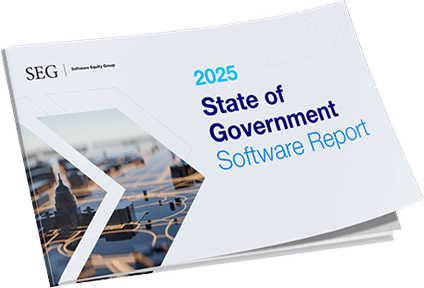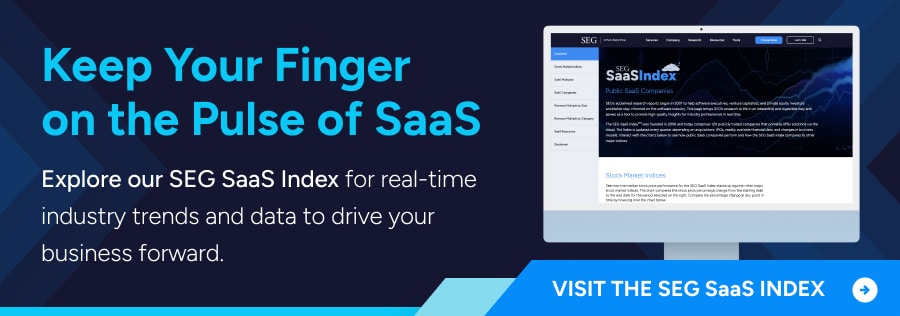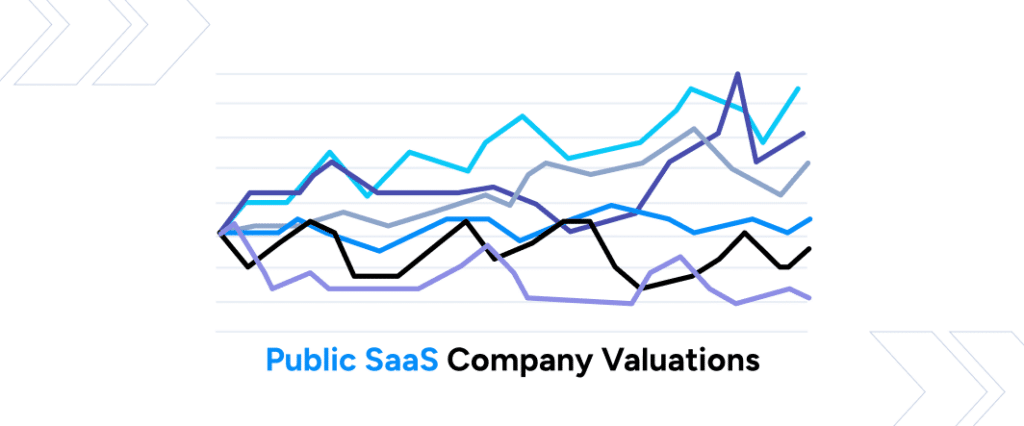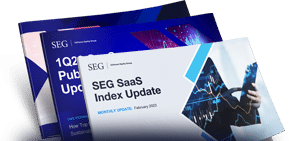The 5 Influences Shaping Software M&A Valuations in 2024

Do you know how potential buyers value your SaaS business?
2023 saw a myriad of factors impact SaaS M&A multiples, including economic developments, technological advancements, and a public market rebound.
But what are the key influences shaping valuation multiples in today’s M&A deals?
As you contemplate your exit strategy, it becomes increasingly crucial to understand the external factors driving the valuation of your SaaS company. Potential acquirers will evaluate your company based on these factors, which will influence the enterprise value in a potential exit scenario.
Learn more about the external influences shaping your SaaS company’s valuation multiple below.
#1. Hot Verticals and Product Categories
SaaS businesses, in general, have taken the tech world by storm over the last decade. The advantages of subscription-based software have become abundantly clear to customers, and the SaaS business model has been incredibly successful (and often lucrative) for entrepreneurs. In any given year, however, some sectors of the SaaS universe are more prosperous than others, depending on industry trends, global economics, and other influences.
As indicated by our 2024 Annual SaaS Report, M&A activity over the last year may reveal which types of companies will be sought-after targets in the foreseeable future. For example, the report found that vertically focused businesses comprised nearly half of all SaaS deals in 2023 (48%), a significant increase from the year before. Buyers and investors have adapted to the current markets and prioritized durable and sustainable M&A targets. They’re buying companies that offer mission-critical solutions that serve recession-resistant end markets.
The most active verticals in 2023 were Healthcare, Financial Services, and Real Estate. Healthcare has remained the most active vertical (17% of vertical SaaS deals), driven by the essential nature of healthcare operations regardless of economic climate. Second was financial services (14%), as financial firms leaned on technology amidst a tight operating environment driven by increased capital costs. Other top verticals included Government and Energy, as the critical nature of these end markets makes SaaS M&A volume resilient to market dynamics.
As for key product categories, SaaS businesses focused on Sales and Marketing led the pack in 2023 with 294 transactions. The Analytics and Data Management category was second in 2023, with 285 deals. Also of note, ERP / Business Management saw stable M&A volume in 2023, which mirrors its consistent growth and steady valuations in the public markets and further demonstrates the category’s mission-critical nature.
#2. The Key Metrics that Matter Most to Buyers
There are many ways to measure the success of SaaS businesses, and founders would be wise to keep a close on key performance indicators well before they’re interested in pursuing an exit opportunity. Our most recent data, however, suggests that prospective buyers and investors place particular importance on two key factors when valuing acquisition targets: profitable growth and revenue retention.
In our recent Buyers’ Perspectives survey, feedback revealed that buyers were most hungry for companies achieving strong revenue growth without burning through cash at an unsustainable rate. In other words, they placed a high value on profitably growing targets. Gross revenue retention was also high on their list of priorities, showing that companies can hang on to existing customers. Buyers find these qualities especially desirable in uncertain times when risk aversion is significant.
While the survey indicated substantial demand for such high-quality companies, the supply didn’t match. This was perhaps due to a widespread perception that 2023 was a “bad time to sell.” If those perceptions continue in 2024, it could create tremendous opportunities for profitable or breakeven SaaS companies that pair growth with strong retention to strike while the iron is hot.
It’s important to remember that no key metric exists in a vacuum. Ultimately, your valuation will depend on the context in which your key metrics exist, a mixture of quantitative and qualitative factors. Critical quantitative factors include revenue retention, annual recurring revenue growth, and gross margin. In contrast, qualitative factors could be judged more subjectively, such as delivery and pricing models and product positioning in the market.
#3. Economic and Business Trends
Aside from the things you can control, such as your business operations and financial management, a wide variety of external factors – from macroeconomic conditions to evolving trends in the business world – could impact your valuation. For example, one specific economic factor to keep an eye on is interest rates set by the Federal Reserve. In 2022 and 2023, the Fed raised interest rates repeatedly to counteract high inflation. However, as inflation abated somewhat in early 2024, most experts believe the Fed will begin to lower rates again by the end of this year. Lower interest rates make access to capital (i.e., borrowing money) less expensive, and thus, companies are likely to be more aggressive in their acquisition strategies. For software entrepreneurs, a low-rate environment could translate to a significantly higher valuation, making it a great time to sell.
Concurrently, it appears as though the Fed has been successful in facilitating a “soft landing” and avoiding the recession that many economists had predicted. If the economy is in relatively good shape and companies aren’t overly concerned about a severe downturn, it bodes well for M&A activity and healthy valuations.
As for business trends that might impact SaaS company valuation multiples, digital transformation continues to be among the top priorities for companies of all shapes and sizes, and SaaS plays a central role in that endeavor. Even amidst economic headwinds in 2023, the SEG SaaS Index™ increased 34% YOY, outpacing the S&P 500 and Dow Jones. And there were over 2,000 SaaS M&A transactions, the second highest year on record. These facts make it clear that the software ecosystem is already strong and resilient and should continue to flourish in 2024 under more favorable economic conditions.
An especially interesting trend to watch will be the rise of artificial intelligence and its impact on the world around us. The explosive growth of generative AI (led by ChatGPT) was one of the biggest stories of last year and will continue to make headlines as consumers and businesses attempt to capitalize on new opportunities. The world’s growing obsession with AI is already impacting the greater software universe as companies rush to equip their offerings with AI-driven capabilities. Thus, the degree to which SaaS businesses are involved or aligned with AI could greatly impact their valuations.
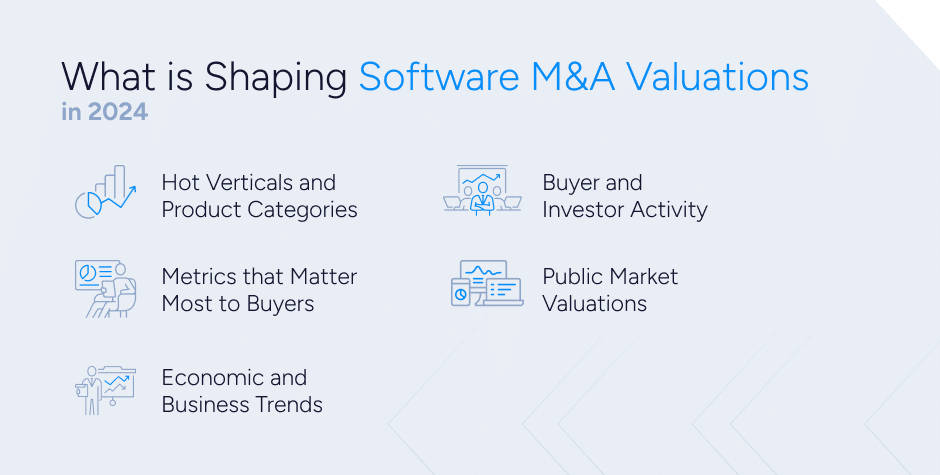
#4. Buyer and Investor Activity
We tend to group M&A buyers and investors into two main categories: strategic buyers and private equity firms. Strategic buyers typically want to buy a SaaS firm to grow or improve their own company, whereas a PE firm buys a SaaS business as an investment, intending to resell it later. Understanding the difference and familiarizing yourself with the landscape can help you, as a SaaS entrepreneur, position yourself effectively among interested parties and achieve a better valuation.
In 2023, most SaaS M&A deals were led by PE investors. Theoretically, the challenging stock market through most of the year caused many strategic buyers to forgo the risk of M&A activities, opening the door for PE firms to grab the most attractive targets. However, in Q4 of 2023, strategic buyers made a comeback and had their most active quarter since Q1 2022, an indication that activity may be more balanced among buyer types in 2024.
The takeaway for SaaS founders is that when PE firms and strategic buyers actively pursue M&A deals, higher demand could equate to higher valuations as companies compete for attractive targets.
#5. Public SaaS Multiples
Even if your business is privately owned, your valuation could be impacted by the stock prices of publicly traded SaaS companies. Why? It’s partly a matter of perception. When the valuations of public SaaS companies are struggling in the public eye of the stock market, it creates a feeling throughout the industry that SaaS businesses, in general, are not suitable investments at the time.
But there’s more to it than that. Buyers and investors look at comparable transactions conducted by public companies to inform their own valuations of acquisition targets. So, when public SaaS multiples are down, it can place downward pressure on private SaaS M&A deals as well. Furthermore, public companies tend to value businesses as a function of their own valuation. In other words, if the buyer’s valuation is down, they will be less likely to place a premium on M&A targets.
If you’re considering whether to put your company on the market, depressed valuations of public companies don’t necessarily mean you should put those plans on hold. Markets will always prioritize growth. Among the SEG SaaS Index™ (116 publicly traded SaaS companies), companies that grew more than 40% received a median EV/TTM revenue multiple of 10.9x in 4Q23, up 31% YOY against 4Q22. As mentioned earlier, profitability earns a premium as well. In 4Q23, companies with >20% EBITDA margin saw a median multiple of 7.4x, a decrease of 13% YOY from 8.5x, but a 28% premium to the Index median. The rest of the cohort had a median multiple of 8.0x.
Bottom line: if your company has strong fundamentals of profitable growth and revenue retention, it could still be a great time to sell and receive a healthy valuation, regardless of what’s happening in the stock market.
The 20 Factors Behind SaaS Company Valuation Multiples
Suppose you’re unsure where your business stands; start with the 20 Factors scorecard in our updated whitepaper. If you need help using it, SEG offers a non-obligatory strategic assessment at no charge, and we will not keep or use your company’s information. We aim to give you the tools and knowledge you need for the highest valuation possible. Contact us today to ask questions or get your assessment started.

